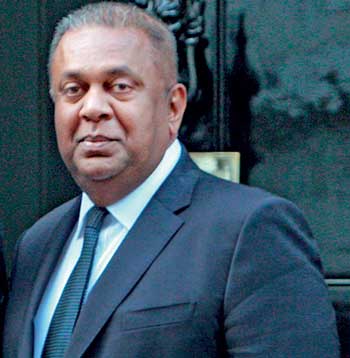30 Mar 2018 - {{hitsCtrl.values.hits}}
 By Chandeepa Wettasinghe
By Chandeepa Wettasinghe
The Finance Ministry’s amnesia on the Sri Lankan economy from 2005 to 2014 may lead visitors to the ministry’s official webpage wonder what exactly had happened to the country’s economy during the period.
The Finance Ministry, in its website, has listed the ‘Economic Phases’ of Sri Lanka, which include the ‘Journey Since Independence’ from 1948 to 1955, ‘The Emphasis on Self Reliance’ from 1956 to 1976, ‘Towards an Open Economy’ from 1977 to 2005 and ‘Vision 2025’ from 2015 onwards.
The 2006 to 2014 period, which was missing from the Finance Ministry’s history lesson, was from the time when former President Mahinda Rajapaksa was the Finance Minister.
Interestingly, a link from a separate part of the website outlines a ‘Vision for the Future’ from 2005 to 2014, but it links to the ‘Vision 2025’ page.
The Rajapaksa era saw Sri Lanka return to being one of the most protected countries on earth, a theme which is strong in SLFP’s political ideology and was present during the 1956 to 1976 period as well. In both cases, a handful of monopolists and oligopolists dominated the economy at the cost of the consumers.
The SLFP has repeatedly implemented these policies of keeping away foreign competition with the intention of ‘empowering local industries’.
However, the Rajapaksa regime also implemented some of the largest infrastructure projects in the country’s history, including much needed highways, but also an airport and a port, which are considered white elephants, through expensive Chinese funding.
The current government came into power by accusing the Rajapaksa government of corruption by pointing out the high price tags on the projects, and the benefits enjoyed by Rajapaksa loyalists at the taxpayers’ expense.
Rajapaksa however is also well respected for being able to push through projects.
The Finance Ministry’s amnesia with regard to this period of history does not seem to have rubbed off on its political master, since Finance & Mass Media Minister Mangala Samaraweera is always quick to point out the Rajapaksa era dictatorship and economic mismanagement which has restricted the economic policy directions of the current government.
While the ministry appears to have forgotten all about these developments during the 9-year period in question, it has admitted the constraint of the current government to get things done like Rajapaksa did.
“As in all democracies, progress is often not made in straight lines. Sri Lanka too, like all other countries in the world, is susceptible to the influence of global developments, natural disasters, and related challenges, and faces setbacks as a result,” the ministry website said.
However, the ministry does not have any qualms about accepting reports and statistics published between 2005 and 2014, which economists have pointed out could be a mistake of the current government due to concerns over the previous government massaging data.
Finance Ministry however extolled the current government’s vision on eradicating corruption, re-establishing democracy, promoting ethnic harmony, improving international relations and uplifting the economy in the ‘Vision 2025’ economic phase, it failed to explain the fingers being pointed by President Maithripala Sirisena and international organizations on corruption occurring today.
The Finance Ministry website also has failed to mention that during the current economic phase, its former Finance Minister and another UNP loyalist, the former Central Bank Governor Arjuna Mahendran, were linked to the biggest bank heist in the country’s history, costing public funds billions of rupees through government bond auctions conducted by the Central Bank.
“As in all democracies, progress is often not made in straight lines. Sri Lanka too, like all other countries in the world, is susceptible to the influence of global developments, natural disasters, and related challenges, and faces setbacks as a result,” the ministry website said.
However, the ministry does not have any qualms about accepting reports and statistics published between 2005 and 2014, which economists have pointed out could be a mistake of the current government due to concerns over the previous government massaging data.
Finance Ministry however extolled the current government’s vision on eradicating corruption, re-establishing democracy, promoting ethnic harmony, improving international relations and uplifting the economy in the ‘Vision 2025’ economic phase, it failed to explain the fingers being pointed by President Maithripala Sirisena and international organizations on corruption occurring today.
The Finance Ministry website also has failed to mention that during the current economic phase, its former Finance Minister and another UNP loyalist, the former Central Bank Governor Arjuna Mahendran, were linked to the biggest bank heist in the country’s history, costing public funds billions of rupees through government bond auctions conducted by the Central Bank.
18 Nov 2024 6 hours ago
18 Nov 2024 7 hours ago
18 Nov 2024 7 hours ago
18 Nov 2024 8 hours ago
18 Nov 2024 18 Nov 2024